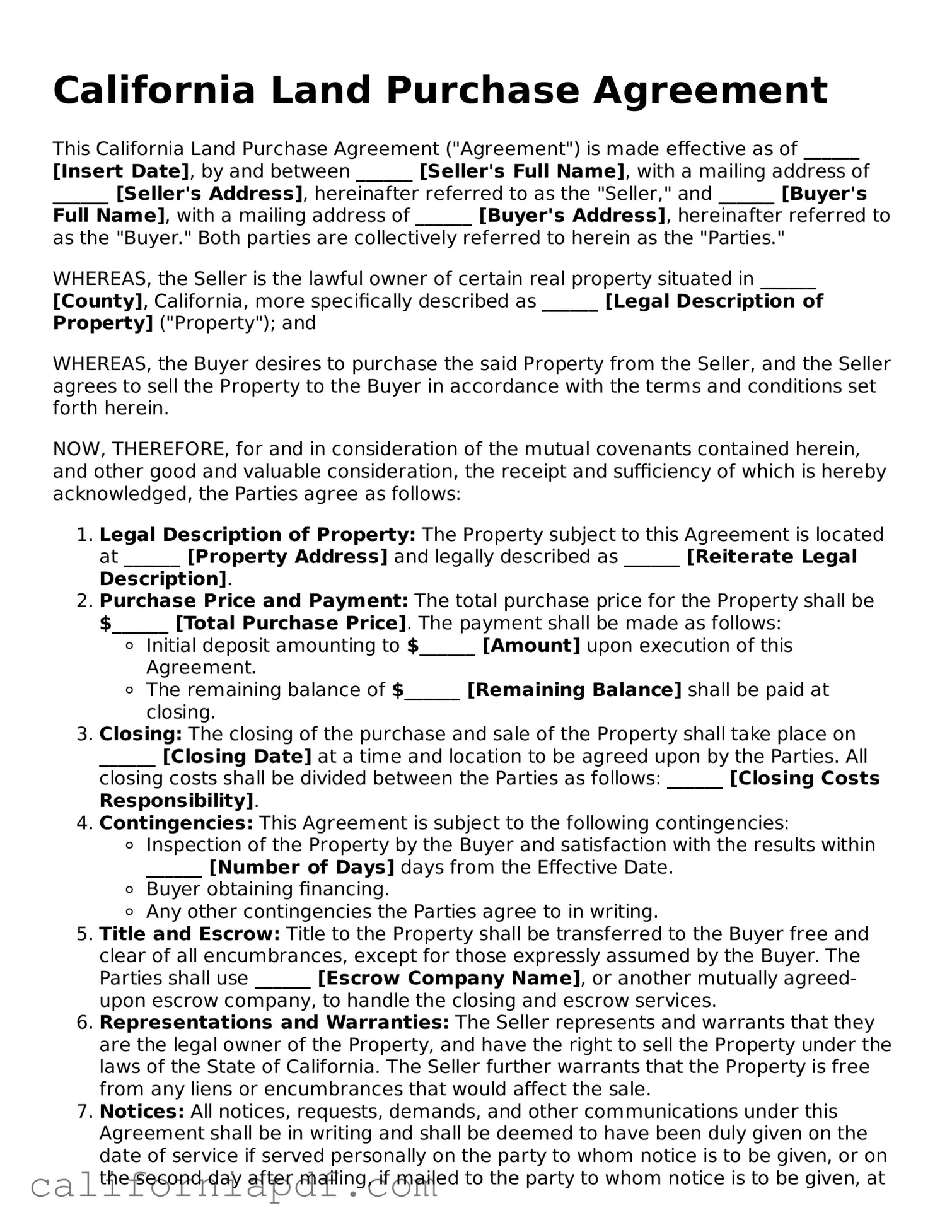California Land Purchase Agreement
This California Land Purchase Agreement ("Agreement") is made effective as of ______ [Insert Date], by and between ______ [Seller's Full Name], with a mailing address of ______ [Seller's Address], hereinafter referred to as the "Seller," and ______ [Buyer's Full Name], with a mailing address of ______ [Buyer's Address], hereinafter referred to as the "Buyer." Both parties are collectively referred to herein as the "Parties."
WHEREAS, the Seller is the lawful owner of certain real property situated in ______ [County], California, more specifically described as ______ [Legal Description of Property] ("Property"); and
WHEREAS, the Buyer desires to purchase the said Property from the Seller, and the Seller agrees to sell the Property to the Buyer in accordance with the terms and conditions set forth herein.
NOW, THEREFORE, for and in consideration of the mutual covenants contained herein, and other good and valuable consideration, the receipt and sufficiency of which is hereby acknowledged, the Parties agree as follows:
- Legal Description of Property: The Property subject to this Agreement is located at ______ [Property Address] and legally described as ______ [Reiterate Legal Description].
- Purchase Price and Payment: The total purchase price for the Property shall be $______ [Total Purchase Price]. The payment shall be made as follows:
- Initial deposit amounting to $______ [Amount] upon execution of this Agreement.
- The remaining balance of $______ [Remaining Balance] shall be paid at closing.
- Closing: The closing of the purchase and sale of the Property shall take place on ______ [Closing Date] at a time and location to be agreed upon by the Parties. All closing costs shall be divided between the Parties as follows: ______ [Closing Costs Responsibility].
- Contingencies: This Agreement is subject to the following contingencies:
- Inspection of the Property by the Buyer and satisfaction with the results within ______ [Number of Days] days from the Effective Date.
- Buyer obtaining financing.
- Any other contingencies the Parties agree to in writing.
- Title and Escrow: Title to the Property shall be transferred to the Buyer free and clear of all encumbrances, except for those expressly assumed by the Buyer. The Parties shall use ______ [Escrow Company Name], or another mutually agreed-upon escrow company, to handle the closing and escrow services.
- Representations and Warranties: The Seller represents and warrants that they are the legal owner of the Property, and have the right to sell the Property under the laws of the State of California. The Seller further warrants that the Property is free from any liens or encumbrances that would affect the sale.
- Notices: All notices, requests, demands, and other communications under this Agreement shall be in writing and shall be deemed to have been duly given on the date of service if served personally on the party to whom notice is to be given, or on the second day after mailing, if mailed to the party to whom notice is to be given, at their address stated above, or at such other address as any party may give to the other in writing pursuant to this section.
- Governing Law: This Agreement shall be governed by and construed in accordance with the laws of the State of California, without regard to its conflict of laws provisions.
- Entire Agreement: This Agreement constitutes the entire agreement between the Parties and supersedes any prior understandings, agreements, or representations by or between the Parties, written or oral, to the extent they related in any way to the subject matter hereof.
IN WITNESS WHEREOF, the Parties have executed this California Land Purchase Agreement as of the date first above written.
Seller's Signature: ____________________________________ Date: ______
Buyer's Signature: ____________________________________ Date: ______
